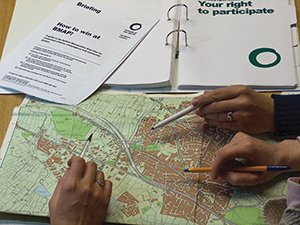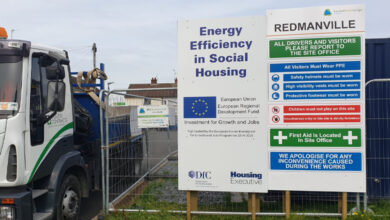Local development planning
Addressing the recent Local Government Reform Conference, Lisburn and Castlereagh City Council Principal Planner Lois Jackson outlined the importance of local development plans.
 “Local Development planning is a key planning function. Local development planning provides certainty and a framework for investment to secure future generations’ needs,” explained Principal Planner Lois Jackson. The system allows for sustainable growth, a strong focus on community involvement and allows for speedier decision-making. “Society operates better within a clear and secure structure, local development planning certainly helps provide this structure for society to grow and develop,” she added.
“Local Development planning is a key planning function. Local development planning provides certainty and a framework for investment to secure future generations’ needs,” explained Principal Planner Lois Jackson. The system allows for sustainable growth, a strong focus on community involvement and allows for speedier decision-making. “Society operates better within a clear and secure structure, local development planning certainly helps provide this structure for society to grow and develop,” she added.
The plan-led systems means that planning decisions must have regard to local development plans, giving primacy to this in decision-making. The system must be based on a sound evidence base and ensure effective and meaningful community participation. Jackson explained: “This means listening to people and asking: what actually makes places better? Then making that answer tangible.” It requires built-in monitoring and review; the plan should never be a stagnant document sitting on a shelf.
Local development planning must take account of the Regional Development Strategy 2035, the Strategic Planning Policy Statement and other central government policies. Jackson outlined the stages of the process: Firstly, a preferred options paper; followed by a plan strategy; then producing a local policies plan. This will then be subject to a five-year review. She remarked: “In my opinion, councils only face difficulties when they try to deviate substantially from this.”
 Jackson told delegates that sustainability is key to the process: “Sustainability sometimes seems quite terrifying but as a planner the first image that appears in my head is the three pillars of sustainability: Economy, society and environment. Then getting the balance right between each of the three. I quite like the dictionary definition of sustainability: to continue or be continued for a long time. Keep both in mind and you can’t go far wrong.”
Jackson told delegates that sustainability is key to the process: “Sustainability sometimes seems quite terrifying but as a planner the first image that appears in my head is the three pillars of sustainability: Economy, society and environment. Then getting the balance right between each of the three. I quite like the dictionary definition of sustainability: to continue or be continued for a long time. Keep both in mind and you can’t go far wrong.”
Outlining the stages in the process, she emphasised that each is extremely important. Preparatory position papers are the first stage and provide factual evidence based proposals. “In Lisburn and Castlereagh, we have completed 10 in areas such as housing, economic development and tourism and presented them to the planning committee. In turn, this allowed us to have focused workshops to explore and tease out the key issues affecting the council area. This generated healthy debate among members who are ultimately responsible for new plans for their area.”
This first stage also involves a statement of community involvement. This sets out the council’s policy for involving the community in development proposals and explains how the community will be engaged including during the preparation of the plan, applications and enforcement. Jackson remarked: “Involving the community up front and as early as possible is extremely important, we want to achieve the best outcomes in the public interest.”
In preparing its timetable, the council will consult with the Planning Appeals Commission and seek approval from the Department of the Environment. Jackson said it was important to review the timetable annually, making the community aware and providing greater transparency.
“The majority of people out there probably do not even know there is a local development plan for their area. We need to change the perception and make it real to people and make them aware of the planning for the area in which they live.” In her experience even planning students have not known about local development plans.
The second stage of the process is the preferred options paper which involves the first public consultation on the local development plan. It will also set out a series of options for dealing with key strategic issues in the area and include the council’s preferred option. The plan strategy sets out the objectives and growth strategy taking account of regional policy. The local policies plan must be in line with the plan strategy and will then outline proposals including settlement limits, zonings and designations.
A new requirement of the system is public examination and soundness. There are 12 tests in total including assessing consistency, coherence and effectiveness. The independent examiner will report to the Department of the Environment, who will then issue a binding report to the council. The plan can then be adopted.
The next stage is monitoring and reviewing, which measures how the objectives have been achieved. Housing and employment land will be monitored each year. Reviews will be undertaken on plans at least every five years.
The new local development plan must take account of the council’s community plan. Jackson highlighted an opportunity for ongoing community engagement and a joint vision for the community plan and the local development plan. “What we don’t want is consultation fatigue – which is very common in the public sector – we do want the public to be fully involved in both processes and have realistic expectations as a result. I think that’s probably most important.”
What will it mean? “As I’ve outlined the plan is really quite technical, complex and process driven and there is no getting away from that, but – the important bit – we have to look at what the outcome will actually achieve in creating better places for people to live and work. I believe it will improve people’s quality of life.”
She added that the framework will improve infrastructure whilst protecting and enhancing the environment. It will also provide the opportunity for job creation and promotion of prosperity.
“My closing advice to you, should you be a planner, councillor or involved in shaping proposals – always remember the end goal.”





